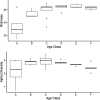The core microbiome of cultured Pacific oyster spat is affected by age but not mortality
- PMID: 39162495
- PMCID: PMC11448229
- DOI: 10.1128/spectrum.00031-24
The core microbiome of cultured Pacific oyster spat is affected by age but not mortality
Abstract
The Pacific oyster is the most widely cultured shellfish worldwide, but production has been affected by mortality events, including in hatcheries that supply the seed for growers. Several pathogens cause disease in oysters, but in many cases, mortality events cannot be attributed to a single agent and appear to be multifactorial, involving environmental variables and microbial interactions. As an organism's microbiome can provide resilience against pathogens and environmental stressors, we investigated the microbiomes in cohorts of freshly settled oyster spat, some of which experienced notable mortality. Deep sequencing of 16S rRNA gene fragments did not show a significant difference among the microbiomes of cohorts experiencing different mortality levels, but revealed a characteristic core microbiome comprising 74 taxa. Irrespective of mortality, the relative abundance of taxa in the core microbiomes changed significantly as the spat aged, yet remained distinct from the microbial community in the surrounding water. The core microbiome was dominated by bacteria in the families Rhodobacteraceae, Nitrosomonadaceae, Flavobacteriaceae, Pirellulaeceae, and Saprospiraceae. Within these families, 14 taxa designated as the "Hard-Core Microbiome" were indicative of changes in the core microbiome as the spat aged. The variability in diversity and richness of the core taxa decreased with age, implying niche occupation. As well, there was exchange of microbes with surrounding water during development of the core microbiome. The shift in the core microbiome demonstrates the dynamic nature of the microbiome as oyster spat age.IMPORTANCEThe Pacific oyster (Magallana gigas, also known as Crassostrea gigas) is the most widely cultivated shellfish and is important to the economy of many coastal communities. However, high mortality of spat during the first few days following metamorphosis can affect the seed supply to oyster growers. Here, we show that the microbiome composition of recently settled oyster spat experiencing low or high mortality was not significantly different. Instead, development of the core microbiome was associated with spat aging and was partially driven by dispersal through the water. These findings imply the importance of early-stage rearing conditions for spat microbiome development in aquaculture facilities. Furthermore, shellfish growers could gain information about the developmental state of the oyster spat microbiome by assessing key taxa. Additionally, the study provides a baseline microbiome for future hypothesis testing and potential probiotic applications on developing spat.
Keywords: 16S rRNA; Crassostrea gigas; Magallana gigas; Pacific oyster; amplicon sequencing; aquaculture; core microbiome; metamorphosis; spat.
Conflict of interest statement
The authors declare no conflict of interest.
Figures






Similar articles
-
The prokaryotic and eukaryotic microbiome of Pacific oyster spat is shaped by ocean warming but not acidification.Appl Environ Microbiol. 2024 Apr 17;90(4):e0005224. doi: 10.1128/aem.00052-24. Epub 2024 Mar 11. Appl Environ Microbiol. 2024. PMID: 38466091 Free PMC article.
-
Understanding the Dynamic of POMS Infection and the Role of Microbiota Composition in the Survival of Pacific Oysters, Crassostrea gigas.Microbiol Spectr. 2022 Dec 21;10(6):e0195922. doi: 10.1128/spectrum.01959-22. Epub 2022 Oct 31. Microbiol Spectr. 2022. PMID: 36314927 Free PMC article.
-
Characterisation of the Pacific Oyster Microbiome During a Summer Mortality Event.Microb Ecol. 2019 Feb;77(2):502-512. doi: 10.1007/s00248-018-1226-9. Epub 2018 Jul 10. Microb Ecol. 2019. PMID: 29987529
-
From Farm to Fingers: an Exploration of Probiotics for Oysters, from Production to Human Consumption.Probiotics Antimicrob Proteins. 2020 Jun;12(2):351-364. doi: 10.1007/s12602-019-09629-3. Probiotics Antimicrob Proteins. 2020. PMID: 32056150 Review.
-
The Pacific Oyster Mortality Syndrome, a Polymicrobial and Multifactorial Disease: State of Knowledge and Future Directions.Front Immunol. 2021 Feb 18;12:630343. doi: 10.3389/fimmu.2021.630343. eCollection 2021. Front Immunol. 2021. PMID: 33679773 Free PMC article. Review.
Cited by
-
The prokaryotic and eukaryotic microbiome of Pacific oyster spat is shaped by ocean warming but not acidification.Appl Environ Microbiol. 2024 Apr 17;90(4):e0005224. doi: 10.1128/aem.00052-24. Epub 2024 Mar 11. Appl Environ Microbiol. 2024. PMID: 38466091 Free PMC article.
References
-
- FAO . 2018. The state of world fisheries and aquaculture 2018. Rome
-
- Li Y, Qin JG, Abbott CA, Li X, Benkendorff K. 2007. Synergistic impacts of heat shock and spawning on the physiology and immune health of Crassostrea gigas: an explanation for summer mortality in Pacific oysters. Am J Physiol Regul Integr Comp Physiol 293:R2353–62. doi:10.1152/ajpregu.00463.2007 - DOI - PubMed
-
- Burge CA, Judah LR, Conquest LL, Griffin FJ, Cheney DP, Suhrbier A, Vadopalas B, Olin PG, Renault T, Friedman CS. 2007. Summer seed mortality of the Pacific oyster, Crassostrea gigas thunberg grown in Tomales bay, California, USA: the influence of oyster stock, planting time, pathogens, and environmental stressors. J Shellfish Res 26:163–172. doi:10.2983/0730-8000(2007)26[163:SSMOTP]2.0.CO;2 - DOI
-
- Cassis D, Pearce CM, Maldonado MT. 2011. Effects of the environment and culture depth on growth and mortality in juvenile Pacific oysters in the strait of Georgia, British Columbia. Aquacult Environ Interact 1:259–274. doi:10.3354/aei00025 - DOI
MeSH terms
Substances
Grants and funding
- GBMF#5600/Gordon and Betty Moore Foundation (GBMF)
- RGPIN-2015-05896,RGPIN-2020-06519/Canadian Government | Natural Sciences and Engineering Research Council of Canada (NSERC)
- #25412/Ministry of Technology, Innovation and Citizens' Services | British Columbia Knowledge Development Fund (BCKDF)
- ACRDP#P-14-02-001/Canadian Government | Fisheries and Oceans Canada (DFO)
- NPRB GSRA#1335/DOC | North Pacific Research Board (NPRB)
LinkOut - more resources
Full Text Sources
Research Materials

